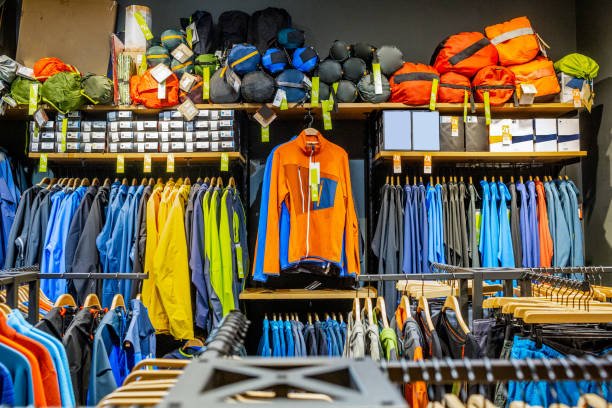Properly storing your camping gear after an adventure ensures it stays in top condition for your next trip into the great outdoors. From tents and sleeping bags to cooking equipment and apparel, taking the time to clean, organize, and safeguard your gear will extend its lifespan and keep you prepared for future excursions. Follow our comprehensive guide to learn the best practices for storing camping gear at home.
The Importance of Proper Storage
Investing in high-quality camping gear is a significant expense, so it’s crucial to protect that investment through proper storage. Exposure to moisture, pests, and extreme temperatures can damage or degrade even the most durable outdoor equipment. Improper storage can lead to mildew growth, insulation deterioration, and fabric degradation, ultimately shortening the lifespan of your gear and compromising its performance.
By following the tips outlined in this article, you’ll not only extend the life of your camping equipment but also ensure it’s ready for your next adventure, saving you time, money, and frustration in the long run.
Cleaning and Drying Gear Before Storage
Before storing your camping gear, it’s essential to clean and thoroughly dry it. Dirt, food residue, and moisture can attract pests and promote the growth of mold and mildew, leading to premature deterioration and unpleasant odors.
Tents and Tarps
After each camping trip, set up your tent and tarps in a shaded area and allow them to dry completely. Use a soft-bristle brush or a clean sponge to gently remove any dirt or debris from the fabric. Avoid using harsh detergents or bleach, as these can damage the waterproofing and coatings. Once dry, carefully fold or roll the tent and tarps according to the manufacturer’s instructions to prevent creasing or stretching the material.
Sleeping Bags and Pads
Sleeping bags and pads should be aired out and cleaned according to the manufacturer’s recommendations. Many sleeping bags can be machine-washed on a gentle cycle with a mild detergent designed for technical fabrics. Hang them to dry completely, fluffing the insulation periodically. For self-inflating sleeping pads, open the valves to allow any moisture to evaporate before storing them.
Cooking Gear
Thoroughly clean all cooking equipment, including pots, pans, and utensils, to remove any food residue. Use a mild dish soap and warm water, and allow everything to air dry completely before storing. For stoves and fuel bottles, ensure they are empty and free of any residual fuel, which can degrade over time and potentially become a fire hazard.

Apparel and Footwear
Wash or spot-clean any dirty or sweaty clothing and footwear according to the care instructions. Ensure they are completely dry before storing to prevent mildew growth and odors.
Creating a Dedicated Storage Space
Designating a specific area in your home for storing camping gear not only keeps everything organized but also helps protect your equipment from potential damage. Consider the following options:
Closet or Cabinet
If you have a spare closet or cabinet, it can be an ideal storage solution for camping gear. Install shelving units or hanging rods to maximize the space and keep items organized. Use clear plastic bins or breathable storage bags to protect gear from dust and moisture.
Garage or Basement
While garages and basements can provide ample storage space, they may be susceptible to temperature fluctuations, moisture, and pests. If using these areas, invest in airtight plastic bins or waterproof storage containers to safeguard your gear. Additionally, consider using a dehumidifier or moisture-absorbing products to control humidity levels.
Attic or Crawl Space
Attics and crawl spaces can be suitable for storing camping gear, but be mindful of potential moisture issues and extreme temperatures. Use sealed plastic bins or breathable storage bags to protect your gear, and check on it periodically for any signs of damage or deterioration.
Proper Packing and Organization
Once you’ve designated a storage area, it’s time to pack and organize your camping gear for easy access and retrieval. Follow these tips for efficient storage:
Label Everything
Clearly label all storage containers, bins, or bags with their contents. This will save you time and frustration when planning your next camping trip. You can use permanent markers, label makers, or even printable labels and tape.
Group Related Items
Keep related camping gear together for easier packing and unpacking. For example, store all cooking equipment in one bin, sleeping bags and pads in another, and so on. This will help you quickly locate what you need and ensure nothing is left behind.

Use Breathable Storage Bags or Bins
While airtight plastic bins are great for protecting gear from moisture and pests, they can also trap moisture and promote mildew growth if items are stored damp. Consider using breathable storage bags or bins with vents or mesh panels to allow airflow and prevent condensation buildup.
Roll or Stuff Sleeping Bags and Pads
Instead of folding sleeping bags and self-inflating pads, stuff them loosely into breathable storage sacks or compression bags. This will help maintain the loft and insulation properties of the materials.
Store Tents and Tarps Loosely
Avoid tightly packing or compressing tents and tarps, as this can cause creases, stretching, or damage to the waterproof coatings. Instead, loosely fold or roll them and store them in breathable bags or bins.
Rotate Gear
If you have multiple sets of camping gear, rotate their use and storage to evenly distribute wear and tear. This will help extend the lifespan of your equipment and ensure everything is in good condition when you need it.
Protecting Gear from Pests and Environmental Factors
In addition to proper cleaning and storage, it’s essential to take steps to protect your camping gear from pests, moisture, and extreme temperatures. Here are some tips to help safeguard your investment:
Pest Control
Pests like mice, insects, and even squirrels can chew through and damage camping gear, especially tents, sleeping bags, and clothing. Use airtight plastic bins or breathable storage bags to prevent pest infestations. You can also place cedar chips, moth balls, or natural repellents in your storage area to deter pests.
Moisture Control
Moisture can lead to mildew, mold, and fabric deterioration, so it’s crucial to keep your camping gear dry. Use a dehumidifier or desiccant packets in your storage area to absorb excess moisture. Additionally, avoid storing gear in basements or other damp areas.
Temperature Regulation
Extreme temperatures can degrade materials and coatings, reducing the performance and lifespan of your camping gear. Ideally, store your equipment in a cool, dry area away from direct sunlight and heat sources. Attics and garages may experience significant temperature fluctuations, so they should be monitored closely.
Regular Maintenance and Inspection
In addition to proper storage, regular maintenance and inspection of your camping gear are essential to ensure its longevity and performance. Here are some tips to keep in mind:

Inspect for Damage
Before and after each camping trip, thoroughly inspect all your gear for any signs of wear, damage, or deterioration. Look for rips, holes, fraying, or worn-out components, and address any issues promptly.
Repair or Replace as Needed
If you notice any damage or wear, repair or replace the affected items as soon as possible. Delaying repairs can lead to further degradation and potential safety issues when camping.
Reapply Waterproofing and Coatings
Over time, the waterproofing and coatings on tents, tarps, and rain gear can wear off or become less effective. Follow the manufacturer’s recommendations for reapplying waterproofing treatments or coatings to maintain their performance.
Clean and Store After Each Use
Always clean and properly store your camping gear after each use, following the steps outlined earlier in this article. Consistent maintenance and care will significantly extend the lifespan of your equipment.
The Benefits of Proper Storage
By following the guidelines outlined in this article, you’ll not only protect your investment in camping gear but also enjoy numerous benefits:
Longer Gear Lifespan
Proper storage and maintenance can extend the lifespan of your camping equipment by several years, saving you money in the long run.
Improved Performance
Well-maintained and stored gear will perform better and more reliably, ensuring your camping trips are safe, comfortable, and enjoyable.
Ready for Adventure
With your camping gear properly stored and organized, you’ll be ready to hit the trail at a moment’s notice, without the hassle of searching for lost or damaged items.
Peace of Mind
Knowing your valuable camping gear is protected and ready for your next adventure will give you peace of mind and allow you to focus on planning your next outdoor excursion.
Camping Gear Storage Checklist
| Gear | Clean & Dry | Proper Storage Container | Storage Location | Pest Control | Moisture Control | Inspect & Maintain |
|---|---|---|---|---|---|---|
| Tents & Tarps | ✔ | Breathable bag/bin | Cool, dry area | ✔ | Dehumidifier | ✔ |
| Sleeping Bags & Pads | ✔ | Breathable sack/compression bag | Cool, dry area | ✔ | Desiccant packets | ✔ |
| Cooking Gear | ✔ | Plastic bin | Cool, dry area | ✔ | Dehumidifier | ✔ |
| Apparel & Footwear | ✔ | Breathable bags | Cool, dry area | ✔ | Desiccant packets | ✔ |
Tips and Tricks
Use a vacuum storage bag for bulky items like sleeping bags and puffy jackets. The vacuum seal will compress the items, saving valuable storage space while still allowing airflow to prevent moisture buildup.
Store tents and tarps loosely rolled or folded around a pool noodle or cardboard tube. This prevents creasing and ensures the fabric retains its shape.
Invest in a hanging storage system or shelving units with adjustable shelves to maximize vertical space in your storage area. This keeps gear organized and easily accessible.
Label storage containers not only with the contents but also with the season or trip they’re intended for (e.g., “Summer Camping,” “Backpacking Gear,” etc.). This streamlines packing for specific adventures.
Create a camping gear inventory list, either physical or digital, to keep track of what you have and its condition. This helps identify when items need to be replaced or repaired.
Silica gel packs are an excellent moisture-absorbing option for storing in bins or bags with your gear. They can be easily recharged by heating in the oven or microwave.
Use specialized gear lofts or racks designed for storing tents, sleeping bags, and pads. These allow proper ventilation and maintain the shape and loft of the gear.
Store camping cookware and utensils in a dedicated container or bin, separating them from other gear to prevent scratches or damage.
Line storage bins or shelves with a waterproof tarp or plastic sheeting to provide an extra layer of protection against moisture or spills.
Rotate your gear’s storage location periodically, especially if storing in an attic or garage with temperature fluctuations. This evens out wear and tear from environmental factors.
Consider using airtight plastic bins for storing items like sleeping bags and clothing during the off-season to protect against pests and moisture.
Take advantage of compact, collapsible storage solutions like stuff sacks or compression bags for space-saving storage of items like sleeping bags and clothing when not in use.
FAQs: Storing Camping Gear at Home
Can I store my camping gear in the basement?
While basements can provide ample storage space, they may be prone to moisture issues, which can damage camping gear. If storing gear in the basement, use airtight plastic bins or breathable storage bags, and monitor humidity levels closely.
How often should I inspect my camping gear for damage?
It’s a good practice to thoroughly inspect all your camping gear before and after each trip for any signs of wear, damage, or deterioration. Address any issues promptly to prevent further degradation.
Can I store my tent and sleeping bag in their stuff sacks?
While stuff sacks are convenient for packing and transporting gear, they’re not ideal for long-term storage. Tents and sleeping bags should be loosely stored in breathable bags or bins to prevent compression and maintain their loft and insulation properties.
Is it okay to store camping gear in the attic?
Attics can be suitable for storing camping gear, but they may experience extreme temperature fluctuations, which can degrade materials and coatings. If using an attic, monitor temperatures and use breathable storage bags or bins to protect your gear.
How can I prevent pests from damaging my camping gear?
Use airtight plastic bins or breathable storage bags to prevent pest infestations. You can also place natural repellents like cedar chips or moth balls in your storage area to deter pests.
Can I store my camping stove and fuel bottles with the gear?
It’s generally not recommended to store camping stoves and fuel bottles with your other gear, especially if they contain residual fuel. Empty and clean them thoroughly before storing them separately in a well-ventilated area.
How often should I reapply waterproofing treatments to my tent and rain gear?
Follow the manufacturer’s recommendations for reapplying waterproofing treatments or coatings. Generally, it’s a good idea to reapply them every few years or whenever you notice the water repellency diminishing.
Is it okay to store dirty or damp camping gear?
No, it’s essential to clean and thoroughly dry all camping gear before storing it. Dirt, food residue, and moisture can attract pests and promote the growth of mold and mildew, leading to premature deterioration and unpleasant odors.
Final Words
Proper storage and maintenance of your camping gear are essential for extending its lifespan, ensuring optimal performance, and protecting your investment. By following the guidelines outlined in this article, you’ll be able to keep your gear in top condition and be ready for your next adventure into the great outdoors.










